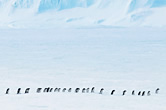
Antarctica, Earth’s driest and coldest continent, has intrigued civilizations for millennia, even when they could only speculate about what lay at “the bottom of the world.” Samuel Taylor Coleridge mentioned it in The Rime of the Ancient Mariner (1797-98), and Jules Verne used it as the setting for An Antarctic Mystery (1897). Its forbidding landscape was the backdrop for the classic 1951 science fiction film The Thing from Another World and its 1982 remake, The Thing, as well as the 1983 Japanese film Nankyoku Monogatari (“Antarctica”), which told the dramatic tale of Japan’s Antarctic research expedition in 1959. Worldwide movie audiences also saw it in March of the Penguins (2005) and Happy Feet (2006), and will see it again this year in Happy Feet 2.
Antarctica’s rich history includes seagoing adventures of explorers and hunters, international political drama and cutting-edge scientific research. Indeed, from its geologic origins to its significance for the future of Earth’s climate, Antarctica is a mystery humans are determined to solve, a continent of science where new wonders are waiting to be discovered.
The Greeks thought there had to be a giant land to the south, but it took hard work and heroics to prove it. From prehistoric times and the first waves of explorers to Cold War intrigue and modern-day researchers, the history of Antarctica is one of extraordinary changes and challenges. See how the continent has become a part of human history.
Antarctica is a virtual magnet for meteorites. And, it turns out, it is also a treasure trove of intriguing minerals formed right here on Earth. What can this teach us about the past? Meteorites and minerals tell the tale of a solar system and a supercontinent, formed over mind-numbing stretches of time. And they are helping scientists better understand how the Earth came to be.
Believe it or not, Antarctica is telling us a lot about heat. Water from deep in the ocean around the frozen continent circulates around the Earth, helping regulate its climate and temperature. And because of its location, Antarctica is the perfect place to study air currents, the ozone layer, and the mechanisms of global warming.
-


- Nikon Cameras — Tough Enough for the Antarctic
The Sankei Shimbun photojournalist, Nobuo Serizawa, accompanied the 52nd expedition of the Japanese Antarctic Research Expedition (JARE) from November 2010 to March 2011. Serizawa and Nikon cameras captured incredible images that illustrate the otherworldly beauty of Antarctica.
- Nikon Cameras — Tough Enough for the Antarctic
- Antarctica Online
![[Open in a new window]](/common/img/icon/window.png)
Calling itself “the premier source for Antarctic images and information,” this site has sections about Antarctic science, history and culture. There is also information for those interested about working in Antarctica or visiting as a tourist.
- PANSY (Program of the Antarctic Syowa MST/IS Radar)
![[Open in a new window]](/common/img/icon/window.png)
This site covers all aspects of Japan’s pioneering PANSY project. It provides information about PANSY’s research, including photos and illustrative graphics about the atmosphere above the Antarctic. It also has links related to PANSY and other research organizations, including the Japanese Antarctic Research Expedition (JARE).
Updated November 11, 2011

